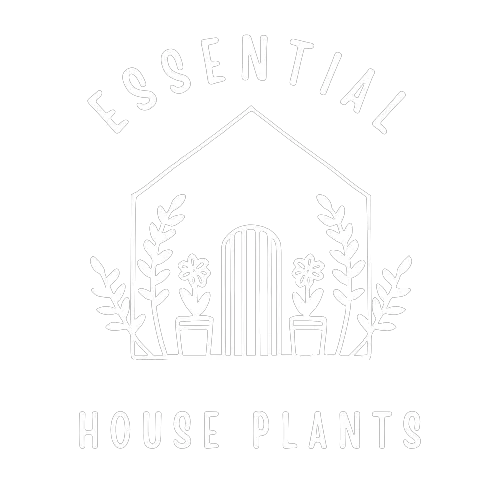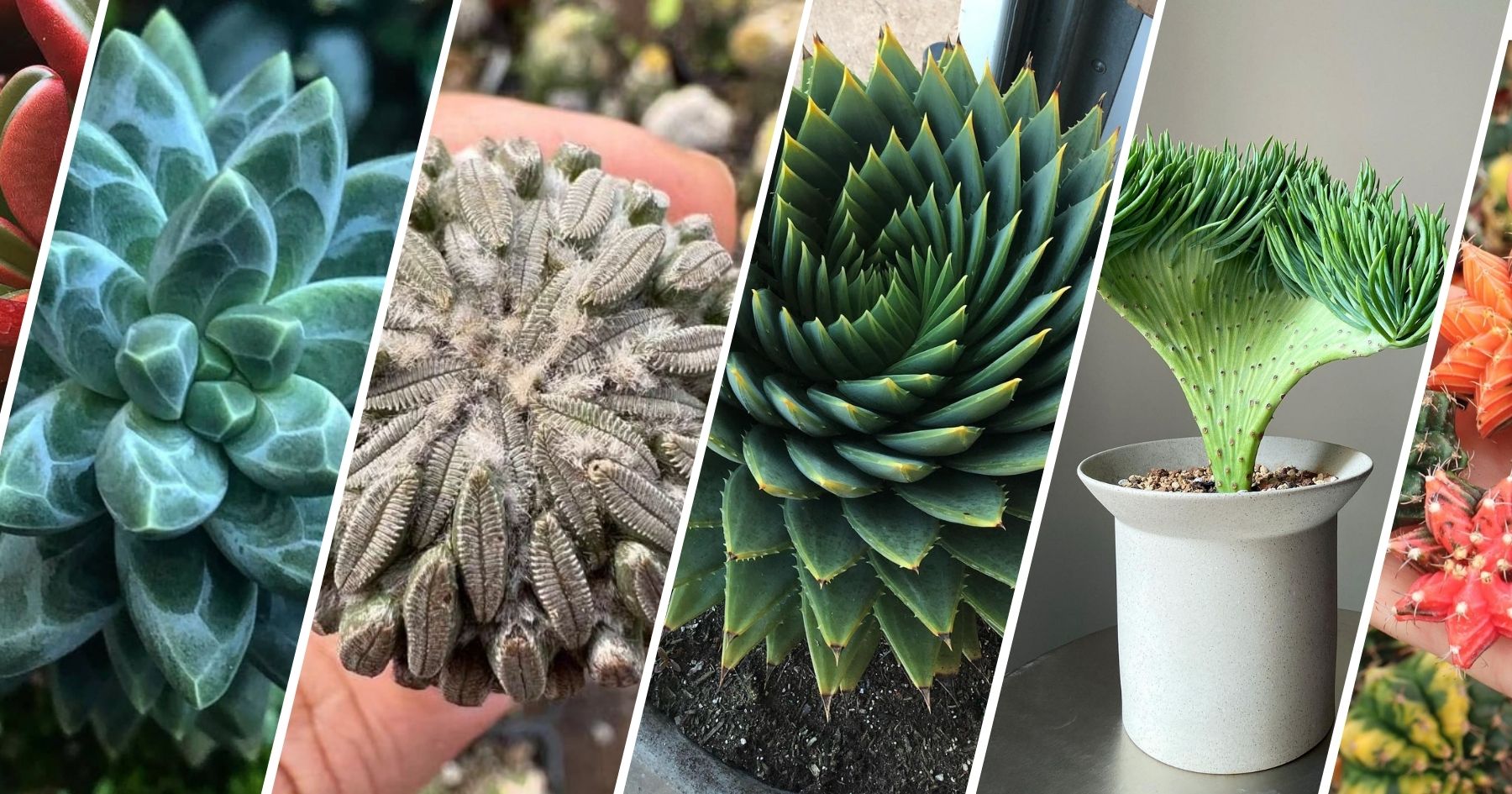There are over 10,000 species of succulents in the world. Some of these are highly popular houseplants, but many more are incredibly rare.
Below are 15 of the rarest succulents in the world. They may be hard to find, but their unique appearances make them absolutely worth the effort to track down.
15 of the Rarest Succulents in the World
Frizzle Sizzle (Albuca spiralis)
 Source: @thelecaqueen
Source: @thelecaqueenThe Frizzle Sizzle bulb succulent has a whimsical look, with long tentacles capped in adorable spirals that look like they were dreamed up by Dr. Suess.
They are native to South Africa and prefer full sun and dry soil, similar to what they experience in their native Western Cape. Giving this amazing plant too little light or too much water will cause the leaves to straighten, eliminating that fun and unique spiral feature.
One reason these cute succulents are so rare as houseplants is that they tend to go dormant in summer if grown in optimal conditions for producing tight spirals.
This causes many gardeners to give up on them, thinking they are dead. But don’t fret, after the heat of July has passed, they will wake up curlier and cuter than ever.
Woodlouse Cactus (Pelecyphora aselliformis)
 Source: @ilse.hopper
Source: @ilse.hopperThe Woodlouse Cactus looks like a ball cactus covered in sowbugs or woodlouse. It produces brilliant pink flowers that only open in the afternoon when exposed to sunlight. It’s native to Mexico and thrives in high-elevation hills and plains.
These cactuses are rare in general, but specimens with “own roots” rather than grafted rootstock are a truly unique find.
These plants prefer nutrient-dense soil with limestone added. Allow the soil to dry completely between watering and place in a sunny location.
Pangolin Plant (Crassula barklyi X Crassula perfoliata var. minor-Crassula tecta)
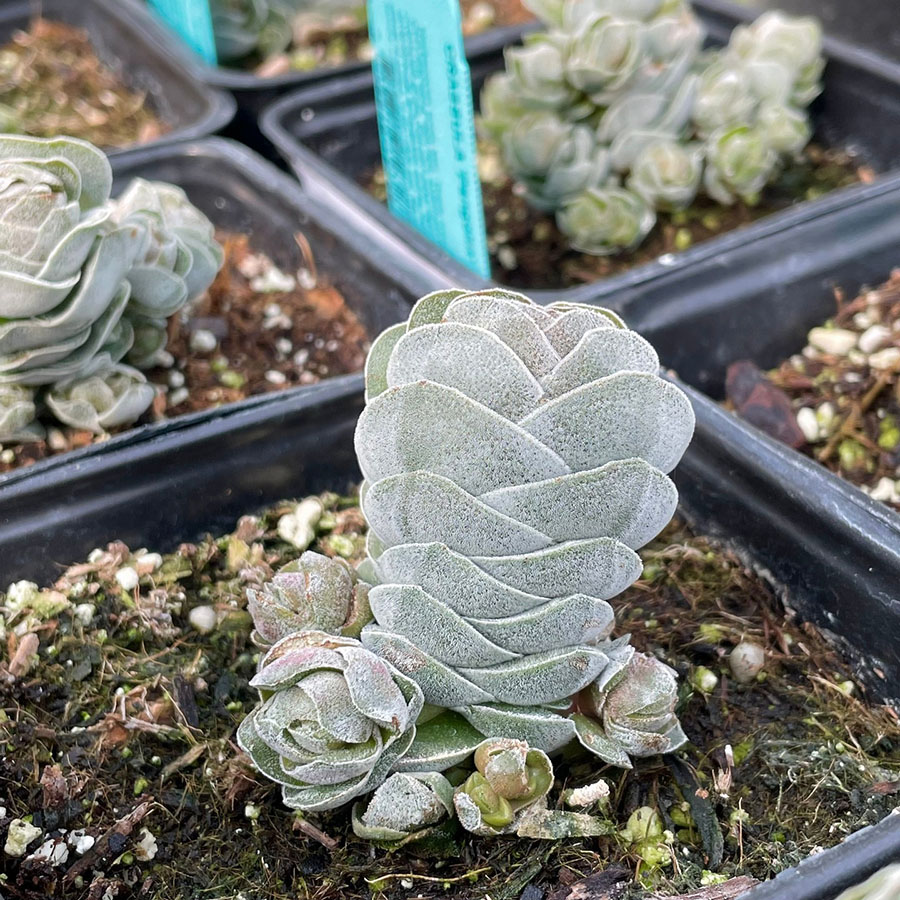 Source: @ruthbancroftgardennursery
Source: @ruthbancroftgardennurseryThe Pangolin succulent is a hybrid species created by the Huntington International Succulent Introduction program. It gets its name from its unique overlapping leaves which resemble the scales of a pangolin anteater.
The color can vary from light green to dark green but is always muted by a soft coat of white that covers the entire plant.
They are relatively easy to care for but are susceptible to mealy bugs. Like most succulents, they prefer infrequent watering and for the soil to dry out in between waterings.
If well cared for, after a couple of years, they produce a bouquet of honey-scented white flowers that grow from the ends of the scaled “trunks.”
Living Stones (Lithops)
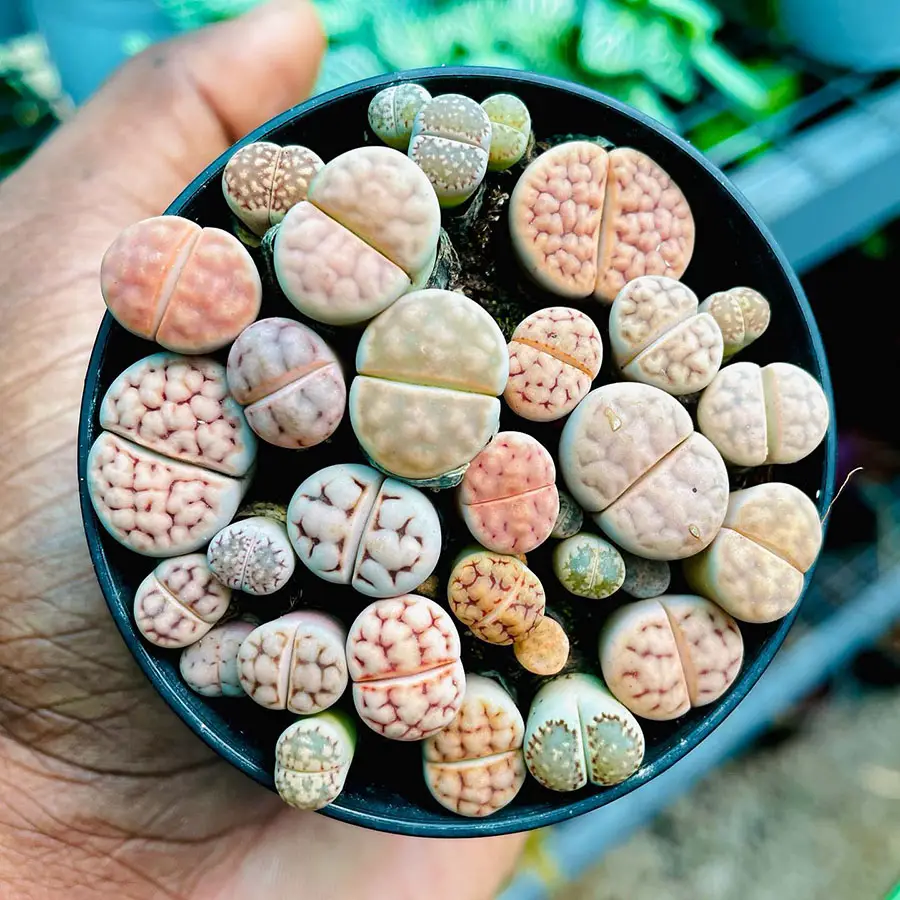 Source: @story_ofplants
Source: @story_ofplantsThis genus of succulents is called Pebble Plant or Living Stones due to their resemblance to small rocks. They come in a variety of colors and can have spotted or striped leaves.
The color and pattern of the plant often mimic the surrounding rocks and environment, an evolutionary adaptation to help the plants avoid being eaten.
These succulents are native to southern Africa and are well adapted to a very dry environment. Let the soil dry out completely between waterings and be sure your plant gets plenty of light.
Lithops are slow-growing and rarely get over an inch wide.
Little Jewel (Pachyphytum compactum)

Little Jewel succulents have fat leaves with pointed ends and grow in a star-like pattern. But what really makes these plants unique are the subtle white markings that cover the blue-green leaves and red-purple tips. These markings rfesemble the wispy reflections of light through water.
These fun little succulents are a hybrid species made by crossing Pachphytum and Echeveria. They are relatively easy keepers so long as they get well-drained soil and part to full sun.
Fish Skin Euphorbia (Euphorbia piscidermis)
 Source: Reddit
Source: RedditFish Skin Euphorbia looks about as pretty as the name suggests, but its unique “beauty” certainly makes for a notable addition to any succulent collection. The small, scale-like leaves grow over one another and feature a thick white fur that hardens as the plant matures.
This plant is native to Ethiopia and is just as rare in the wild as it is as a household plant. It grows only in high-elevation brushland and is limited to two main growing sites. While they are very resilient and somewhat easy to care for, propagation is difficult.
Mini Desert Rose (Trichodiadema densum)
 Source: @jurupamountainsdc
Source: @jurupamountainsdcThis cactus shrub, known as the Mini Desert Rose, has small, compact leaves that grow in clumps with a crown of barbs on the ends. They produce multiple gorgeous red-pink flowers.
One highly unique feature of this rare succulent is it can be grown as a bonsai-like tree with the right cultivation methods.
These cheerful succulents are native to the Western Cape province in South Africa. Unlike most succulents, they prefer frequent, light waterings. They still need plenty of sunshine and well-draining soil, however.
The Mermaid Tail Succulent (Crested Senecio Vitalis)
 Source: @plantgroovy
Source: @plantgroovyOne of the most unique looking of the rare succulents is The Mermaid Tail. This variety, known more specifically as the Crested Mermaid Tail, has an upright stem that fans out at the top. The comb of thin, elongate leaves on the top edge, gives it the look of a mermaid tail.
This is another succulent native to the Cape region of South Africa. It does well in partial shade and isn’t overly picky about moisture levels as long as it has well-draining soil. They are long-growing succulents and a great option for novices if you can track one down.
Spiral Aloe – (Aloe Polyphylla)

Spiral Aloes are a succulent in the aloe family with leaves that grow in a distinctive spiral pattern. These leaves can be bright green to grayish blue in color. They are native to the Drakensberg mountains in southern Africa.
Because of their neat look, these plants are highly sought after as ornamental and decorative features. Unfortunately, they are quite difficult to care for and often die if removed from their native habitat.
On top of that, it’s illegal to harvest these plants or their seeds in South Africa, but they are cultivated and sold in other countries.
Variegated Moon Cactus (Gymnocalycium mihanovichii f. variegata)
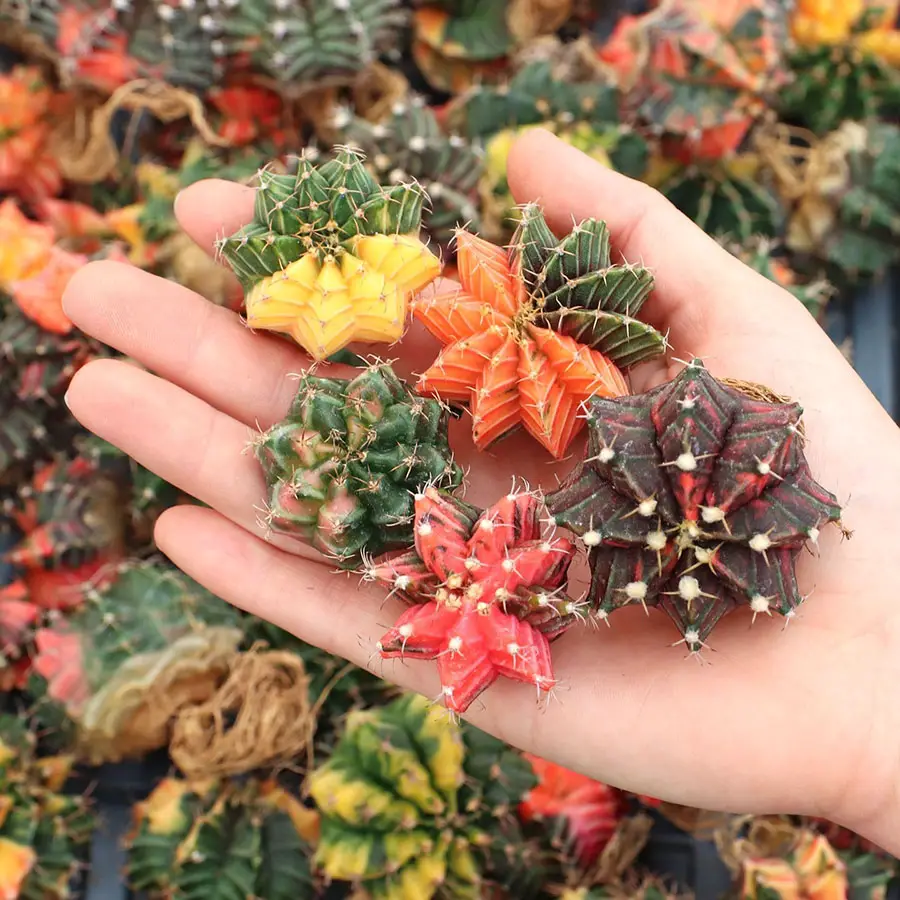 Source: @mountaincrestgardens
Source: @mountaincrestgardensThe Variegated Moon Cactus has a similar shape and look to a typical ball cactus with one key difference: these cacti are colorful. Each specimen varies widely in the amount of color present and the variety of colors they show, but yellow, orange, red, pink, and purple are common. These cacti are mutated versions of the wild South American species.
Variegated versions contain a mutation that disrupts normal pigmentation to create a variety of colors on a single plant. Regular Moon Cacti, which can be solid yellow, pink, or red, are much more common and often sold grafted to hylocereus bases.
Star Fish Flower (Stapelia desmetiana)
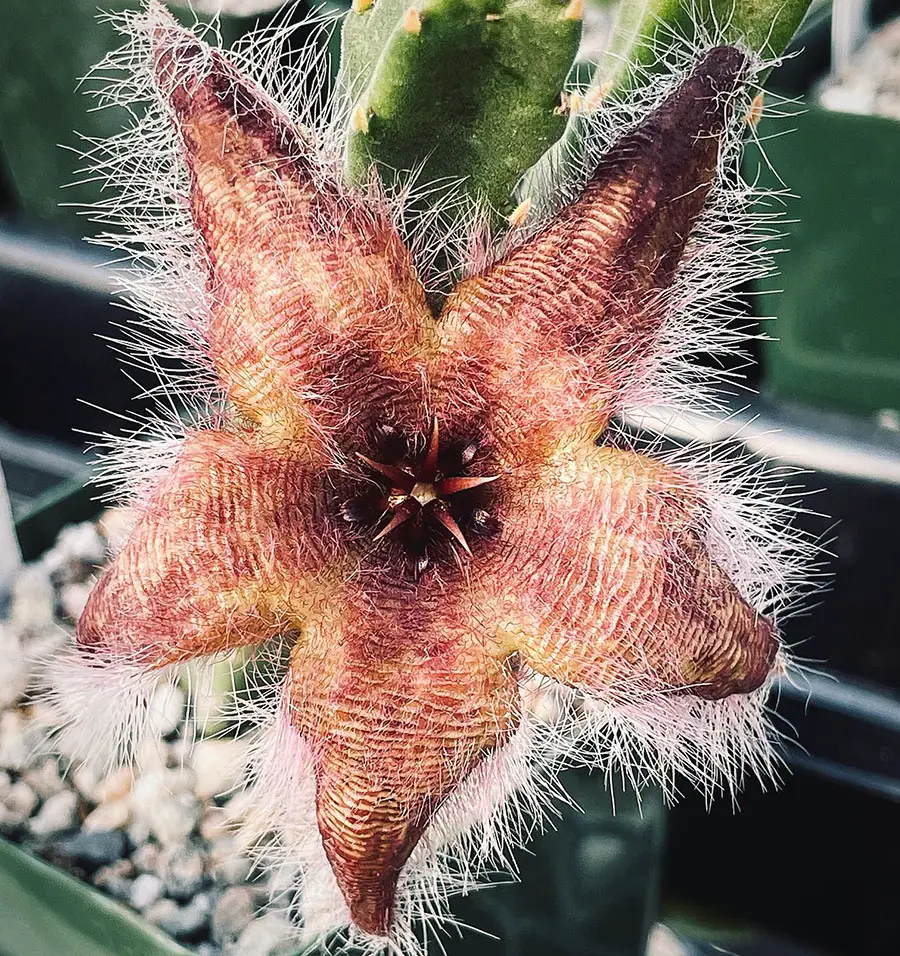 Source: @nightshade.botanicals
Source: @nightshade.botanicalsStar Fish Flowers, also known as Carrion Flowers, look beautiful with their large, fuzzy, star-shaped flowers in shades of yellow, pink, red, and purple. But the smell they release is far less pretty thanks to its rotting-flesh aroma meant to attract flies.
The body of this succulent consists of thick, leafless stems with an upright growth habit. These plants are native to South Africa and fairly easy keepers, minus the offensive aroma each time they flower.
Fairy Tale Plant (Tylecodon schaeferianus)
 Source: @succulent_de_jardin
Source: @succulent_de_jardinThis adorable succulent, known as the Fairy Tale Plant, has bulbous, pale green leaves, sometimes with red mottling. The mix of larger mature leaves and smaller growths gives it a whimsical, fairy tale look. It produces delicate pink or white flowers in the summer.
Like so many other succulents, this one is native to South Africa. It prefers partial shade and is relatively easy to care for. But do note that those cute egg-shaped leaves are toxic.
String of Turtles (Peperomia prostrate)
 Source: @plants_itsavibe
Source: @plants_itsavibeIf you love the popular String of Pearls succulent, let me introduce you to String of Turtles. This plant has a similar cascading growth pattern but instead of ball-like leaves, it has flat, round leaves. Each of these cute little leaves has a mottled dark green pattern similar to what you might see on a turtle shell.
This plant is native to the rainforests of Brazil and prefers humid environments and soil that stays mostly moist, but never wet. It needs indirect sunlight and warmer temperatures. It tends to do well in most household environments and is slowly becoming more popular as a house plant.
The Dude (Deuterocohnia brevifolia)
 Source: @tallahasseenurseries
Source: @tallahasseenurseriesEasily the largest succulent on this list is The Dude, also known as The Deut. This bromeliad succulent is made up of hundreds of tiny bromeliad rosettes. Each is bluish-gray and has stiff, serrated leaves.
In the deserts of Argentina and Bolivia, it grows in dense, sprawling mounds. But when grown in pots, it often takes on a ball-like shape that can grow as large as 5 feet or more in diameter. These plants like it hot and dry with plenty of sunshine and can be grown outdoors in the warmer parts of the US.
Ruby Glow (Peperomia graveolens)
 Source: @paramoplantas
Source: @paramoplantasThis brilliant succulent, known as Ruby Glow , pairs a vivid red on the bottom of the leaves with bright green on the tops. The leaves are elongated with a concave shape, resembling little canoes. The plant produces tiny, bunched flowers on a long stem that smell, very unfortunately, like mouse urine.
Also known as Peperomia Graveolens, these unique succulents are native to the high mountains of the Ecuadorian Andes. They do well in low light and require fast-draining soil. They are fairly easy to care for and make for a gorgeous addition to succulent collections if you can track one down.
